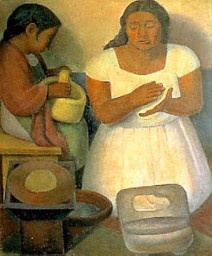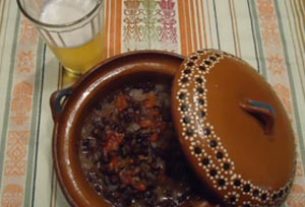Mexican Kitchen
It is nearly impossible to walk more than a block in any Mexican town without encountering a food vendor or two, with either stands on the street or small storefront businesses. The national affinity for snacking has given rise to an unbelieveable array of antojitos y botanas – appetizers and snacks – most of which are based on corn dough, or masa. It is estimated that the average Mexican eats over a pound of corn dough daily, mostly in the form of tortillas; in rural areas, 70% of the daily caloric intake is from this source.
While researching my book, The Cuisine of Puebla, Cradle of Corn, I had the opportunity of exploring the many uses of corn dough, both in the Puebla-Tlaxcala area and as far afield as the Yucatan, Oaxaca, and western Mexico. While the regional variations are deliciously different, depending upon local chiles, cheeses, herbs and spices, the process of making corn dough, the basis of tortillas, is nearly the same in the country as a whole, and has been since pre-Hispanic times. The tortilla as the “daily bread” of Mexico is much more nutritious than the corn itself, thanks to a process which has been employed since the ancient New World inhabitants began transforming wild corn into human food.

This process, called nixtamalization, uses either wood ash or slaked calcium hydroxide, called cal or tequesquite (“builder’s lime” in English) to soak the corn kernels and soften their often-tough outer skin. Besides making the grain easier to grind, nixtamalization increases the protein value of corn by releasing bound niacin, and helps to preserve the masa, which would quickly become sour without it. Anthropologists have dated household equipment for nixtamalization to as early as 1500-1200 B.C, and the rise of the great Mesoamerican civilizations coincides with the beginning of nixtamalization.
Although many people, especially in the rural areas of Mexico, continue to prepare corn dough in the traditional way, the tortillería, along with the availability of packaged masa harina mix (which has been nixtamalized, its nutritional content listed right on the package, and is widely sold outside of Mexico) has made the soaking and grinding of hominy kernels less frequently practiced in recent years. This process is time-consuming and labor-intensive, and the right kind of corn is not easily available outside of Mexico. However, the making of classic corn masa is described in the recipe link following this article, for those who have the inclination and access to this type of dried hominy.
Although fresh tortillas can be purchased almost anywhere in Mexico, the same is not true of other places, and the sorry state of packaged supermarket tortillas makes the homemade variety worth the little bit of extra effort. You will need a tortilla press, an inexpensive item available in kitchen supply stores and Hispanic markets. Ordering through the internet is also a popular option; entering the words “tortilla press” in a search engine yielded over twenty on-line sources for ordering tortilla presses of various dimensions in a choice of wood, cast iron or aluminum. For the actual baking, a comal or griddle can be used; one reserved exclusively for tortilla-making will season nicely.
Following are two methods of making corn dough and instructions for making tortillas. Next month, regional specialties based entirely on tortillas will be featured. Mexicans generally eat a large, multi-course main meal, and many of the foods that are classified in Mexico as appetizers, snacks and brunches, such as tacos and enchiladas, are served as lunch, and even dinner, north of the border. The word antojito, after all, means “little whim”, so make up some masa, use your imagination, and serve tortilla-based treats any time at all, in the true Mexican spirit of satisfying a culinary whim.
- Masa de Maíz: Classic Corn Dough
- Masa de “Masa Harina”: Corn Dough from Packaged Masa Harina Mix
- Tortillas



Your food blog is interesting. From masa to Mesa, I didn’t know that there are many faces of Tortillas. It is the main ingredient in Mexican cuisine and is a favorite of many in the country. With your content, I discovered Mexican kitchens. Now I know that the daily bread or tortilla of Mexico is not only delicious but also nutritious. Thank you also for sharing the process of making human food in ancient times in Mexico.